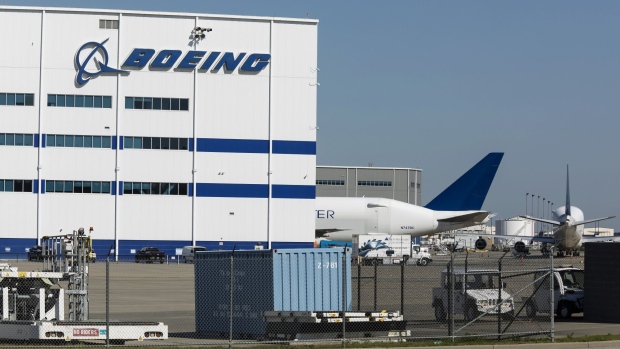Oct 1, 2020
Boeing spurns Seattle to move all 787 output to South Carolina
, Bloomberg News

Boeing Co. is uprooting the 787 Dreamliner program from a storied manufacturing hub north of Seattle and shifting the work to a non-union plant in South Carolina amid slumping sales of wide-body jetliners.
Production of the marquee twin-aisle jetliner will be consolidated in North Charleston in mid-2021 by the company’s best estimate, Boeing said in a statement Thursday. The planemaker is assessing the potential impact on jobs at its factory complex in Everett, Washington, where it employs about 30,000 people and also makes other wide-body models.
The move bolsters Boeing’s decade-long expansion in South Carolina, which hosts the company’s only final jetliner assembly line outside its century-old manufacturing base in Washington state. As the company braces for years of weak orders, consolidation also raises doubts about the future of Boeing’s mammoth wide-body factory in Everett, a plant that was carved out of marsh and forest in the 1960s to house production of the 747 jumbo jet.
The Boeing Co. manufacturing facility stands in North Charleston, South Carolina, U.S., on Monday, May 4, 2020. Boeing is restarting its 787 operations at the plant for the first time since April 8, including all operations that were suspended because of the COVID-19 pandemic, ABC News reported.
“It became clear that consolidating to a single 787 production location in South Carolina will make us more competitive and efficient, better positioning Boeing to weather these challenging times and win new business,” Stan Deal, head of Boeing’s commercial airplane division, said in a message to employees.
In making the decision, Boeing weighed logistics, efficiency and the “long-term health of our production system,” among other considerations, Deal said. The coronavirus pandemic has devastated the company’s sales outlook by sapping demand for flights, especially on the international routes plied by wide-body jets such as the Dreamliner.
Boeing rose 1.4 per cent to US$167.51 at 12:36 p.m. in New York. The shares tumbled 49% this year through Wednesday, the biggest decline on the Dow Jones Industrial Average.
Controversial Plant
Boeing’s 787-only factory in North Charleston has been controversial since inception more than a decade ago, when senior leaders including then-Chief Executive Officer Jim McNerney were chafing at a lengthy Machinists union strike that hobbled manufacturing around Seattle.
Quality issues at the plant drew the attention of U.S. regulators, and came to the fore again in recent weeks as Boeing was forced to ground eight Dreamliners because of potentially dangerous structural weakness.
About 1,000 mechanics and electricians assemble Dreamliners in Everett. Boeing also employs manufacturing and industrial engineers who provide daily support on the factory floor, and design engineers who configure airplanes to each customer’s specifications.
It’s not clear how many engineers might lose their jobs. Many of them support multiple airplane programs and Boeing’s Work Life computer system has been bedeviled by glitches as the company carries out large-scale layoffs, said SPEEA, an engineering union with 17,600 members.
“We believe Boeing is making a mistake,” said SPEEA Executive Director Ray Goforth. “Long term, we will partner with community stakeholders to attract new aerospace jobs to the state by marketing the aerospace talent pool Boeing is walking away from.”
Costly Overhead
Boeing said it will keep building 787s in Washington until it lowers output to a six-airplane monthly rate sometime next year. With the move, the company risks creating a financial drag that lowers the profits of the remaining wide-body programs and its mainstay commercial business.
With 747 production also slated to end by 2022, “the overhead costs will be increasingly borne by the surviving planes, the 767 and 777X, which don’t have a lot of pricing power right now,” said aerospace analyst Richard Aboulafia.
The shift of 787 output to South Carolina had been widely expected, given Boeing’s investment in a brand-new campus, after executives revealed in July that they were studying consolidation of Dreamliner production in a single site. Even so, the decision was panned by Washington Governor Jay Inslee before Boeing officially announced it.
The move would jeopardize about 1,000 jobs, Inslee said in a statement Wednesday, and would force the state to take a “hard look” at the company’s favorable tax treatment.“We have asked the Boeing Company multiple times what it needs to keep 787 production in Washington,” Inslee said.
“This move would signal an allegiance to short-term profits and Wall Street -- not quality, safety and a vision for the future of the industry,” he said.
Cash Burn
Boeing Chief Executive Officer Dave Calhoun and Chief Financial Officer Greg Smith said in July that the company was reviewing its operations, overhead and facilities and focusing spending on critical areas as it faces a market that’s likely to remain depressed for years.
Even before the pandemic, Chicago-based Boeing was embroiled in crisis and scandal because of two deadly crashes of its best-selling 737 Max jet, which has been grounded since March 2019. Boeing could see a staggering US$23.3 billion cash outflow this year, according to Melius Research analyst Carter Copeland, before the resumption of Max deliveries starts to fill the company’s coffers in 2021.
“The goal is to improve cash-flow profile, restore our balance-sheet strength as quickly as possible,” Smith said in July. “And these actions will help get us there.”





